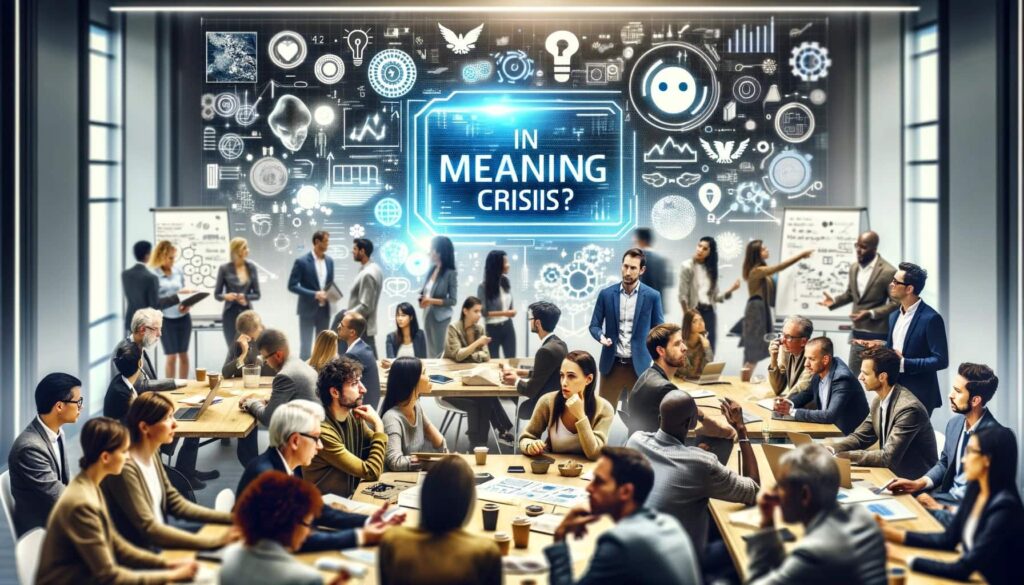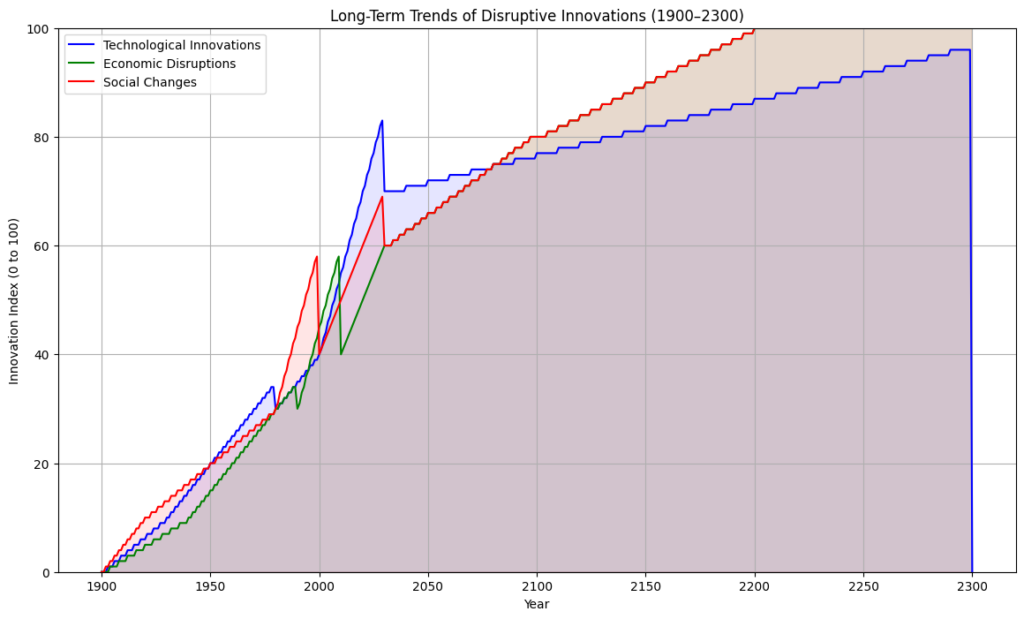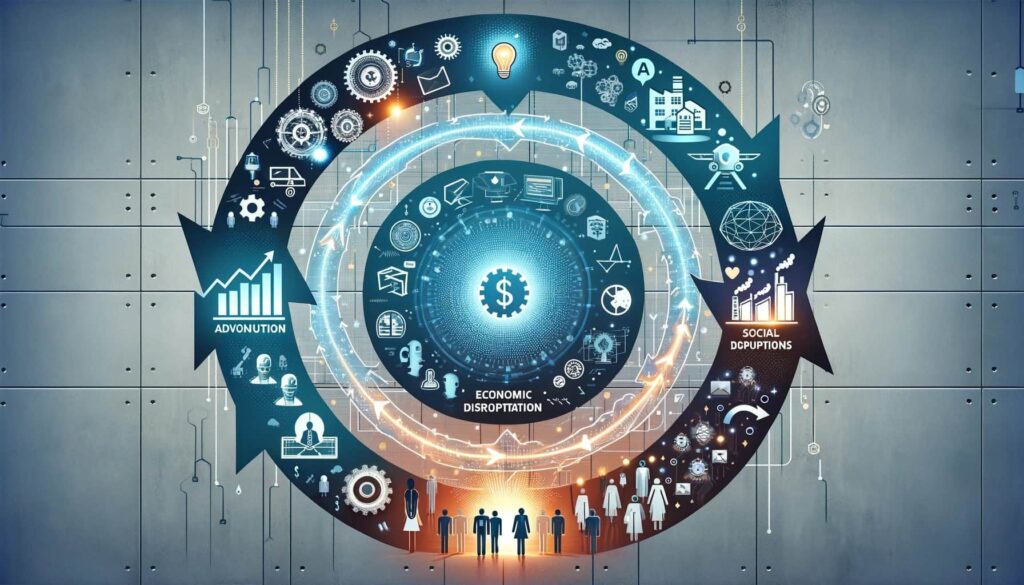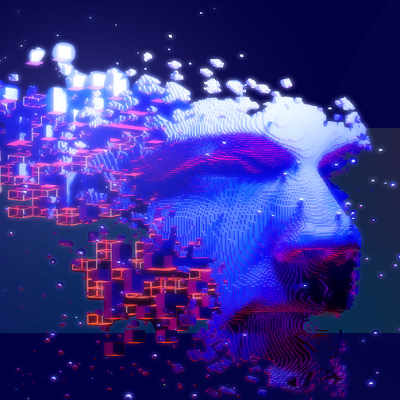Surviving the Automation Tsunami Wave: Navigating the Future of Work
Jun. 01, 2024.
23 min. read.
20 Interactions
The rapid pace of technological advancements challenges norms and job stability. Sharon Gal-Or explores strategies for reskilling, policy interventions, and ethical AI, which are crucial in navigating the Automation Tsunami.
RELATED ARTICLES
Introduction
The rapid advancement of artificial intelligence (AI) and robotics has ushered in an era of unprecedented technological transformation. While this progress promises significant economic and societal benefits, it also poses tough challenges, particularly regarding, loss of meaning, job displacement and socio-economic inequalities. As we stand on the brink of a new era, it is crucial to understand the implications of these changes and develop strategies to survive the ensuing “Automation Tsunami.”
The Cycle of Technological Disruption and Societal Transformation
Technological advancements drive economic disruptions by transforming industries and increasing productivity. This transformation can lead to both job displacement and creation. As industries evolve, societies face significant social shifts as they adapt to new realities, which include fluctuating unemployment rates. These social changes create new demands and priorities, further driving technological innovation and influencing employment patterns.
Impact of Pace on These Relationships
As the pace of technological advancements accelerates, the intensity and frequency of economic and social disruptions increase. This rapid change leads to shorter adaptation periods and heightened volatility in unemployment rates.
As companies struggle to keep up with rapid changes, job displacement increases in the short term. The need for continual reskilling and upskilling becomes essential to maintain employability in this rapidly changing job market, emphasizing lifelong learning. Accelerated social changes occur alongside technological advancements, causing faster shifts in societal norms, values, and priorities. These dynamics contribute to the Meta Crisis, as individuals grapple with finding purpose amid these swift transformations.
Future innovations such as quantum computing, advanced AI, and space colonization are projected to continue transforming society and technology. Economic instability may arise from widespread automation, AI-driven economic decision-making, and shifts in the space economy. Additionally, societal changes driven by transhumanism, human augmentation technologies, and potential societal integration with AI will further shape our future.
- How can we effectively balance the rapid pace of technological advancements with the need for sustainable job creation and economic stability?
- What strategies can be implemented to address the “Meaning Crisis” and ensure individuals find purpose in an increasingly automated world?
- How will future innovations like quantum computing and transhumanism reshape our societal norms, and what ethical considerations should guide their development and integration?
The Meaning Crisis: The Aftermath of the Automation Tsunami Wave
How disruptive innovations effect our lives?
As we navigate the age of disruptive innovations, experiencing multiple ‘Gutenberg events’ simultaneously, the impact of this Tsunami wave on our lives extends far beyond economic statistics and unemployment rates. The rapid pace of technological change often leaves individuals grappling with a profound sense of uncertainty and existential angst, a phenomenon increasingly referred to as the “Meaning Crisis.” Disruptive innovations reshape industries and redefine job roles, often uprooting traditional career paths and destabilizing long-held societal norms. This upheaval can lead to a loss of purpose for many, as the roles and identities that once provided stability and meaning are transformed or rendered obsolete. The constant need to adapt and reskill can be both exhausting and disorienting, leaving individuals questioning their place in an ever-evolving landscape. Moreover, as automation and AI take over routine tasks, the human aspects of work—creativity, empathy, and social interaction—become ever more crucial, yet harder to define and integrate into the new economy. This transition challenges our fundamental understanding of work and its role in our lives, compelling us to seek new forms of meaning and fulfillment amidst the relentless march of progress. The challenge lies not just in keeping pace with technological advancements but in ensuring that these innovations enhance, rather than diminish, our sense of purpose and connection in an increasingly complex world.
According to the World Economic Forum, the displacement effect will see up to 30% of jobs at risk of automation by the mid-2030s. The transition phase due to AI-driven job displacement is expected to be significant and prolonged, potentially spanning decades.
The emergence of AGI presents both challenges and opportunities for economic systems. By anticipating these changes, we can proactively shape a future that harnesses the benefits of AGI while mitigating its risks.
David Shapiro
The McKinsey Global Institute also suggests that while technological advancements will create new jobs and industries, the transition phase could be marked by significant disruptions. Their projections indicate that up to 375 million workers globally might need to switch occupational categories and learn new skills by 2030 to remain employable.
Organizations and thought leaders are advocating for comprehensive policy frameworks to support this transition. Erik Brynjolfsson and Andrew McAfee emphasize the need for policies that promote education, training, and social safety nets to mitigate the adverse effects of automation. They argue that proactive measures are crucial to avoid exacerbating economic inequalities and social unrest during this period.
The disruption of jobs by AI is inevitable, but how we handle this transition will determine our collective future.
Kai-Fu Lee, AI Superpowers
Hyperabundance and the Post-Labor Economy
David Shapiro introduces the concept of “hyperabundance,” where AI and automation significantly increase productivity, potentially leading to a collapse in prices for many goods and services and challenging traditional economic structures. Shapiro emphasizes the need for new economic models, such as Universal Basic Income (UBI), to address reduced aggregate demand caused by widespread unemployment. He also explores the potential for “experience industries” to thrive, offering unique human-centric services and experiences. As Shapiro states, “The emergence of AGI presents both challenges and opportunities for economic systems. By anticipating these changes, we can proactively shape a future that harnesses the benefits of AGI while mitigating its risks”.
Shapiro is not alone in this, most thought leaders discuss the concept of abundance driven by AI and automation. Andrew Ng, co-founder of Google Brain and a prominent AI researcher, emphasizes the potential of AI to address global challenges and drive sustainability efforts, such as in his work with the AI for Earth program. Similarly, Kai-Fu Lee in his book “AI Superpowers” highlights how AI can create an era of abundance but also stresses the need for new social contracts to manage the displacement of jobs and economic shifts.
However, it is important to note that Shapiro and these thought leaders often appeal to an educated audience, which does not necessarily represent the vast population that will be hit hardest by the upcoming tsunami wave of automation. This raises a crucial question: who is representing the poor in this story? The majority of the population affected by these changes may not have the resources or opportunities to adapt quickly, making it essential to consider inclusive policies and support systems to address their needs.
What happens when the pace of technological change is too fast?
The formula to determine the pace of technological change, incorporates several factors:
where:
- 𝐼: Impact index
- 𝑇: Rate of Technological Advancement (number of significant technological advancements per unit time)
- 𝐺: Effectiveness of Government Policies in facilitating adaptation (higher values indicate more effective policies)
- 𝐸: Economic Conditions supporting or hindering adaptation (higher values indicate favorable conditions)
- 𝐶: Cultural Attitudes toward technological change and innovation (higher values indicate more acceptance)
- 𝑅: Rate of Workforce Reskilling and Adaptation (higher values indicate better reskilling capacity)
- 𝑆: Social and Economic System Adaptability (higher values indicate more adaptable systems)
- 𝑃: Psychological Impact on Individuals (higher values indicate higher resilience)
- 𝐿: Time-Lag Coefficient representing the delay between technological advancement and its impact (higher values indicate longer delays)
Application of the Formula
1. Policy Development
Governments can use the formula to identify areas needing policy intervention:
- Example: If 𝐼 is high, indicating rapid technological change and high impact, the government might increase funding for reskilling programs 𝑅, improve economic conditions 𝐸, or implement supportive policies 𝐺.
2. Corporate Strategy
Businesses can apply the formula to anticipate the impact of technological changes on their workforce:
- Example: If a company foresees a high 𝑇 and low 𝑅, it can invest in internal training programs to enhance 𝑅 and prepare employees for upcoming technological changes.
3. Educational Planning
Educational institutions can use the formula to align their curricula with emerging technological trends:
- Example: If 𝐼 is high due to rapid advancements 𝑇 and inadequate reskilling 𝑅, institutions might revise their programs to include more technology-related courses, thereby improving 𝑅.
4. Social Programs
NGOs and community organizations can develop programs to support individuals facing job displacement:
- Example: If the psychological impact 𝑃 is low, indicating high stress and low resilience, social programs focusing on mental health support and resilience training can be implemented to improve 𝑃.
Example Calculation
Assume:
- 𝑇=10 (10 significant technological advancements per year)
- 𝐺=1.2 (Proactive and supportive government policies)
- 𝐸=1.1 (Favorable economic conditions)
- 𝐶=0.9 (Moderate cultural acceptance of change)
- 𝑅=0.8 (Moderate reskilling capacity)
- 𝑆=0.9 (Fairly adaptable systems)
- 𝑃=0.7 (Moderate psychological resilience)
- 𝐿=0.2 (Moderate time-lag)
The formula to calculate the impact index (I) is:
Substitute the given values into the formula:
Step-by-step calculation:
1. Calculate the numerator
2. Calculate the denominator
3. Calculate the Impact Index (I)
Interpretation
- The final calculation for the Impact Index (I) is approximately 0.0509. This indicates a relatively low impact, suggesting that the society is well-adapted to the technological advancements given the current conditions. If the Impact Index were high, it would signify a need for urgent interventions to enhance reskilling, adaptability, and psychological resilience.
The above formula and its application provide a robust framework for assessing when the pace of technological change is too fast, necessitating rapid adaptation. By incorporating factors such as government policies, economic conditions, cultural attitudes, and time-lag effects, the formula offers a comprehensive tool for managing the challenges of rapid technological advancement. This approach enables more informed decision-making and strategic planning, helping societies navigate the complexities of the modern technological landscape while mitigating negative impacts on employment and social stability.

Global Overview
Unlike previous technological shifts, current disruptive innovations affect the entire globe, requiring coordinated efforts across different countries and cultures, each with its own pace of adaptation.
The impact of AI and robotics on unemployment varies significantly between developed and developing countries. AI has the potential to increase global economic activity by approximately $13 trillion by 2030, representing about 1.2% additional GDP growth per year. However, this growth is not evenly distributed, with developed countries likely to benefit more than developing countries.
By 2030, as many as 375 million workers—or roughly 14 percent of the global workforce—may need to switch occupational categories as digitization, automation, and advances in artificial intelligence disrupt the world of work.
McKinsey Global Institute, The Future of Work in America
Developed Countries
In developed economies, the adoption of AI and robotics is expected to lead to significant changes in the labor market. Sectors heavily reliant on repetitive tasks and manual labor, such as manufacturing and logistics, are most at risk. Jobs in these sectors are likely to be automated, leading to a decline in employment rates. For instance, repetitive task jobs could see a decrease from 40% to around 30% of total employment by 2030.
Conversely, there will be increased demand for jobs requiring high digital skills and non-repetitive cognitive abilities. These job profiles are expected to grow from 40% to more than 50% of total employment. Therefore, while certain job categories may diminish, new opportunities in technology-driven roles will arise, albeit requiring substantial reskilling of the workforce.
Developing Countries
Developing countries face different challenges. AI and robotics could exacerbate economic disparities, as these technologies are more readily adopted in advanced economies. This could divert investment away from developing nations, negatively impacting their GDP and employment rates. The transition may see a shift in jobs from labor-intensive sectors to those less reliant on unskilled labor, potentially leading to higher unemployment rates in countries that have traditionally depended on their labor force for economic growth.
Sector-Specific Impacts
- Manufacturing: Automation is expected to reduce the need for human labor in manufacturing, a sector heavily reliant on repetitive tasks.
- Logistics and Warehousing: AI-driven systems and robotics are increasingly used for inventory management and distribution, decreasing the need for manual labor.
- Healthcare: While AI can assist with diagnostics and patient management, it also requires high-skilled professionals to manage and operate these technologies, potentially leading to job displacement among lower-skilled workers.
- Finance: Automation of financial services and use of AI for data analysis could reduce the number of jobs in this sector, but simultaneously create demand for tech-savvy professionals.

Explanation of the Graph: Long-Term Trends of Disruptive Innovations (1900-2300)
The graph illustrates the intensity and frequency of disruptive innovations over time, from 1900 to 2300, categorizing these innovations into three main types: technological innovations, economic disruptions, and social changes. The index values, scaled from 0 to 100, provide an intuitive understanding of the impact of different periods of innovation. This comprehensive view helps us understand how past, present, and future disruptions influence societal transformations.
Key Periods and Trends
1. Technological Innovations (Blue Line)
- 1900-1930: Early industrial innovations such as electrification and the automotive revolution transformed industries and daily life, leading to increased productivity and economic growth. The index rises from 10 to 20.
- 1950–1980: Development of computing technology and the space race marked significant leaps in technological capability. The index increases from 20 to 40.
- 1980–2000: The rise of the internet and mobile technology revolutionized communication, information access, and business, fundamentally transforming society and the economy. The index rises from 40 to 60.
- 2010–2030: Advances in artificial intelligence (AI), renewable energy, and biotechnology are driving significant changes in various industries. The index rises from 60 to 90.
- 2050–2300: Future innovations such as quantum computing, advanced AI, and space colonization are projected to continue transforming society and technology. The index could rise from 90 to 100.
2. Economic Disruptions (Green Line)
- 1920–1940: The Great Depression caused global economic impacts, leading to widespread unemployment and economic hardship. The index rises from 10 to 20.
- 1970–1990: The oil crisis and stagflation led to economic instability and changes in global economic policies. The index increases from 20 to 40.
- 2008–2010: The global financial crisis caused severe economic disruptions worldwide, leading to recessions in many countries. The index rises from 40 to 60.
- 2020–2030: The economic impacts of the COVID-19 pandemic are still unfolding, but they have already caused significant disruptions. The index rises from 60 to 80.
- 2050–2100: Predicted economic disruptions due to climate change impacts, including resource shortages, extreme weather events, and forced migrations. The index could rise from 80 to 90.
- 2100–2300: Potential economic instability from widespread automation, potential AI economic decision-making, and space economy shifts. The index could rise from 90 to 100.
3. Social Changes (Red Line)
- 1900–1920: Movements such as women’s suffrage and labor movements led to significant social changes, improving rights and working conditions. The index rises from 10 to 20.
- 1960–1980: The civil rights movement brought about crucial changes in social justice and equality. The index increases from 20 to 40.
- 1990–2000: The fall of the Berlin Wall and globalization led to major geopolitical and social shifts. The index rises from 40 to 60.
- 2020–2030: Recent social justice movements and the digital revolution are driving substantial changes in society. The index rises from 60 to 80.
- 2050–2100: Predicted social changes due to demographic shifts, including aging populations and increased multiculturalism. The index could rise from 80 to 90.
- 2100–2300: Future societal changes driven by transhumanism, human augmentation technologies, and potential societal integration with AI. The index could rise from 90 to 100.
Key Insights
- Rising Trend: The overall trend of the graph shows a steady increase in the intensity and frequency of disruptive innovations over time. This indicates that technological, economic, and social changes are becoming more frequent and impactful.
- Periods of Significant Growth: The graph highlights specific periods where there was a marked increase in innovation activities, such as the post-war era, the digital revolution, and the early 21st century.
- Future Projections: The projections for the future suggest that the coming centuries will see even more transformative innovations, with significant growth in the innovation index. This reflects the expectation that technological advancements will continue to accelerate.
- Historical Context: The graph provides historical context by showing significant periods of innovation in the past and how they have shaped the present. This context helps in understanding the potential trajectory of future innovations.

Navigating the Automation Tsunami and Transition Phase
Policymakers must address the need for reskilling and upskilling the workforce to ensure that displaced workers can transition into new roles created by technological advancements. Investment in education and continuous learning programs will be crucial to mitigate the adverse effects of AI and robotics on employment, helping to provide new avenues of meaning and stability in a rapidly evolving job market.
Developed countries are generally better positioned to manage the transition due to their existing infrastructure and financial resources. Developing countries may struggle more due to limited resources and larger informal sectors.
International Monetary Fund, World Economic Outlook
Preparedness and Policy Implications
To ensure a smoother transition, countries need to develop comprehensive strategies:
- Education and Training: Emphasize STEM education and digital literacy from an early age.
- Social Safety Nets: Strengthen social protection systems to support those affected by job displacement.
- Innovation and Investment: Encourage investment in new industries and technologies that can create jobs and drive economic growth.
While AI and robotics present significant challenges, proactive measures can help harness their potential for economic and social benefits. Policymakers, businesses, and educators must collaborate to ensure that the workforce is prepared for the future of work.
Developed Countries
United States:
- Policy Initiatives: The U.S. has various initiatives aimed at preparing the workforce for the future, such as the “Future of Work” initiative by the Department of Labor, which focuses on retraining and reskilling.
- Investment in Education: Significant investment in STEM education and partnerships between private companies and educational institutions aim to equip the workforce with necessary skills.
- Challenges: Despite these efforts, there is concern about the pace of change outstripping the ability to retrain displaced workers quickly enough.
European Union:
- Strategic Plans: The EU has launched the Digital Education Action Plan and the European Skills Agenda to enhance digital skills and lifelong learning.
- Funding: Substantial funding is directed towards research and development in AI, with a focus on ethical AI and workforce adaptation.
- Gaps: However, there are disparities between member states in terms of readiness and resources allocated to these initiatives.
Developing Countries
India:
- Government Programs: Initiatives like Skill India aim to reskill millions of workers in technology and other emerging sectors.
- Private Sector Involvement: Companies like Tata Consultancy Services and Infosys are investing in training programs for their employees.
- Challenges: The scale of the workforce and the speed of technological adoption pose significant challenges. Many workers still lack access to basic digital infrastructure.
China:
- National Strategy: China’s AI development plan includes significant investment in AI research, education, and infrastructure.
- Focus on Education: There is a strong emphasis on integrating AI and robotics training into the education system from an early age.
- Rapid Adoption: The pace of AI adoption is very high, but this also means rapid displacement in traditional industries, necessitating swift policy responses.
General Observations
- Global Preparedness: According to the World Economic Forum, there is a substantial gap between the current state of workforce preparedness and what is needed. Many countries are still developing the necessary frameworks and policies.
- Investment in Reskilling: The McKinsey Global Institute highlights the need for massive investment in reskilling programs globally, estimating that up to 375 million workers may need to switch occupational categories by 2030.
- Economic Disparities: The International Monetary Fund (IMF) notes that developed countries are generally better positioned to manage the transition due to their existing infrastructure and financial resources. Developing countries may struggle more due to limited resources and larger informal sectors.
As technology continues to advance, the gap between those who can adapt and those who cannot will widen, leading to significant societal challenges if not properly managed.
Andrew Yang, The War on Normal People

The Automation Tsunami: Understanding the Crisis
The concept of an “Automation Tsunami” encapsulates the sweeping changes brought about by AI and robotics, which are expected to automate many jobs across various sectors. This wave of automation is likely to result in significant job displacement, creating a period of economic and social upheaval.
Statistics and Numbers:
- McKinsey Global Institute: Estimates that by 2030, 400-800 million jobs worldwide could be automated, with 75-375 million people needing to switch occupational categories.
- World Economic Forum: Predicts that by 2025, 85 million jobs may be displaced, but 97 million new jobs may emerge, particularly in data analysis, AI, and green economy sectors.
- Oxford Economics: Forecasts that up to 20 million manufacturing jobs could be lost to robots by 2030.
Overall, while AI and robotics will lead to job losses in some areas, they are also poised to create significant new employment opportunities, emphasizing the need for workforce reskilling and adaptation. There is, however, a period of time where many will be harshly hit by this tsunami wave, creating economic and social challenges.
Job Displacement and Sector Impact
Research by the McKinsey Global Institute suggests that up to 375 million workers worldwide may need to change jobs by 2030 due to automation. The sectors most at risk include manufacturing, logistics, and certain administrative roles. For example:
- Manufacturing: Automation of assembly lines and production processes could lead to the displacement of millions of factory workers.
- Logistics and Warehousing: AI-driven systems and robotics are increasingly used for inventory management and distribution, reducing the need for manual labor.
- Finance: The automation of financial services and data analysis could decrease the number of traditional banking jobs while creating demand for tech-savvy professionals.
In developing countries, the impact could be even more severe due to a lack of resources for reskilling and social safety nets. This disparity underscores the need for a global approach to address the socio-economic challenges posed by automation. We are not prepared for this transition, and as Andrew Yang notes, “As technology continues to advance, the gap between those who can adapt and those who cannot will widen, leading to significant societal challenges if not properly managed.”
Historical Parallels
The Automation Tsunami can be compared to previous technological revolutions that had profound impacts on labor markets:
- Industrial Revolution: Mechanization led to the displacement of many artisanal jobs but eventually created new industries and employment opportunities. The transition was marked by significant social unrest, such as the Luddite movement, but ultimately paved the way for economic growth and improved living standards.
- Digital Revolution: The rise of computers and the internet transformed numerous sectors, rendering some jobs obsolete while creating new ones in IT and digital services. This transition, although disruptive, also resulted in increased productivity and the birth of new industries.
These historical transitions were marked by periods of significant upheaval followed by long-term benefits. The current transition may follow a similar trajectory but at a much faster pace due to the rapid advancement of AI and robotics. The rate of technological change today is unprecedented, requiring quicker adaptation and more robust support systems.
Preparing for the Transition: Strategies and Solutions
To survive the Automation Tsunami, it is imperative to develop comprehensive strategies that address both immediate and long-term challenges. This involves a multi-faceted approach encompassing policy interventions, reskilling programs, and community initiatives.
Policy Interventions
Governments play a crucial role in mitigating the impact of job displacement through proactive policies:
- Universal Basic Income (UBI): Implementing UBI can provide a financial safety net for those affected by job loss, ensuring economic stability during the transition.
- Unemployment Benefits and Social Safety Nets: Expanding these programs can support displaced workers while they reskill and seek new employment opportunities.
- Public-Private Partnerships: Collaborations between governments, private companies, and educational institutions can create effective retraining programs tailored to market needs.
Reskilling and Lifelong Learning
Investment in education and continuous learning is essential to prepare the workforce for future job markets:
- STEAM Education: Emphasizing science, technology, engineering, art and mathematics from an early age can equip individuals with the skills needed for technology-driven roles.
- Lifelong Learning Programs: Offering accessible and affordable retraining opportunities can help workers transition to new job categories and remain employable in a rapidly changing economy.
Community Empowerment and Local Production
Community initiatives can foster resilience and self-sufficiency:
- Regenerative Renaissance: Encouraging communities to shift from overconsumption to self-production, focusing on local production and sustainable practices.
- The “Inner Silk Road”: Promoting self-discovery and personal growth, enabling individuals to contribute meaningfully to their communities and economies.
Technological Inclusivity
Ensuring that technological advancements benefit all segments of society is crucial:
- Ethical AI and Responsible Design: Implementing ethical frameworks and responsible design practices can ensure that AI technologies are inclusive and equitable. As Ben Goertzel from SingularityNET emphasizes, “Ethical AI is essential to ensure that technology serves humanity as a whole and not just a privileged few.”
- Cultural Sensitivity: Designing AI systems that respect and incorporate diverse cultural perspectives can enhance their global applicability and acceptance.
Ethical AI is essential to ensure that technology serves humanity as a whole and not just a privileged few.
Ben Goertzel, SingularityNET
A Call to Action
The Automation Tsunami is about to hit us, and while the exact duration of the transition phase is uncertain, it is clear that it will require coordinated efforts across governments, industries, and educational institutions to ensure that the workforce is adequately prepared and supported. The focus on reskilling, social safety nets, and equitable economic policies will be vital in navigating this complex period of technological transformation.
The Automation Tsunami presents both significant challenges and unprecedented opportunities. By adopting a holistic approach that includes policy interventions, reskilling programs, community empowerment, and ethical AI design, we can navigate this transition effectively. As we move forward, it is essential to embrace the Regenerative Renaissance, fostering self-sufficiency and sustainable practices that ensure a more equitable and resilient future for all.
However, we must acknowledge the harsh reality that many will face significant challenges during this period. As Kai-Fu Lee warns in “AI Superpowers,” “The disruption of jobs by AI is inevitable, but how we handle this transition will determine our collective future.” This sentiment underscores the urgency and importance of our efforts to prepare for the impending changes.
References
- Ahmet Atak, “ETHICAL DESIGN AND RESPONSIBILITIES“
- Andrew Yang, “The War on Normal People”
- David Shapiro, “Post-Labor Economics: How Will the Economy Work after AGI?”
- Erik Brynjolfsson and Andrew McAfee, “The Second Machine Age“
- Global Innovation Index (GII)
- International Labour Organization, “World Employment and Social Outlook 2020”
- Kai-Fu Lee, “AI Superpowers“
- McKinsey Global Institute, “The Future of Work in America“
- Qiaosi Wang, Michael Madaio, Shaun Kane, Shivani Kapania, Michael Terry, Lauren Wilcox, “Designing Responsible AI: Adaptations of UX Practice to Meet Responsible AI Challenges,” CHI ’23: Proceedings of the 2023 CHI Conference on Human Factors in Computing Systems
- World Economic Forum, “The Future of Jobs Report“
Let us know your thoughts! Sign up for a Mindplex account now, join our Telegram, or follow us on Twitter.

.png)

.png)


.png)






12 Comments
12 thoughts on “Surviving the Automation Tsunami Wave: Navigating the Future of Work”
Hi Bradley, thanks so much, yes, it's such a challenge, I saw on LinkedIn someone write "I want AI to do my laundry and dish washing, not my writing and art," which currently it seems the opposite,
P.s. I am filming a documentary in a fishermen village in Raotan Island where old tradition meets progress, and what I can tell you is that there are so many complexities, paradoxes and uncertainties that if we don't learn to manage right, securing long term regenerative solutions, the ones to get hurt are the local fishermen and their families.
Going back to what you said, "I feel the duality of things more than at any other time in history. Modernization has empowered us to be what we are today, but it might also rob us of our modern privileges, if not our existence."
Then, what do you think about the way cultural conditioning is preventing us from releasing the creativity needed to mitigate and transcend our predicament of which the climate emergency, pandemics and geopolitical instability are but symptoms?
🟨 😴 😡 ❌ 🤮 💩
Sharon, thank you for the great piece. Although it is lengthy (longer than a book chapter), it is worthy of the time.
Aren't we living in an interesting time? Our tools are also our existential risks. I feel the duality of things more than at any other time in history. Modernization has empowered us to be what we are today, but it might also rob us of our modern privileges, if not our existence.
Anyway, my question is: Reskilling might be helpful in the short term, but how about the long term? I agree with the other commenters here that the more powerful AIs become, the less chance humans have to continue as part of the workforce. Hence, the time to consider Universal Basic Income is upon us (maybe after two decades).
🟨 😴 😡 ❌ 🤮 💩
Thank you all, Hruy, Aaron, just jeff, alamin rezaq, and everyone joining the conversation. My hope is that the work being done by the good people in the SingularityNET (including Mindplex) ecosystem will lead and inspire humanity toward a better future, as I see Humanity as an exploring species, as in the famous opening line of Star Trek:
“Space: the final frontier. These are the voyages of the starship Enterprise. Its five-year mission: to explore strange new worlds, to seek out new life and new civilizations, to boldly go where no man has gone before.”
In regards of the comments above, I appreciate all, and your insights are incredibly valuable. I think that if this article was a chapter in a book about the future of humanity, we can see that humanity is at the end of horizon one, and your commentm Hruy, would serve as a foundation for the next chapter, which will present the beginning of horizon two (H2), which represents ‘world in transition’— the entrepreneurial and culturally creative space of already technologically, economically and culturally feasible innovations that can disrupt and transform H1 to varying degrees and can have either regenerative, neutral or degenerative socio-ecological effects. In other words, in this upcoming phase, we still use money in our value system, but it's only part of a broader transformation leading to horizon three, where financial capital is no longer a primary value.
In a nutsheel about The Three Horizons of innovation and culture change, all the way from Raotan Island, Honduras, and after a long free dive and snorkling this morning, the 'Three Horizons' framework, is an effective method for facilitating cultural transformation and exploring innovation in the face of uncertainty. It has been applied in various contexts, including technological foresight, rural community development, and executive leadership programs. This framework helps us become more aware of how our individual and collective intentions and behaviors actively shape the future. By mapping three ways of relating to the future from the perspectives of the three horizons, we can foster understanding and future consciousness as the basis for collaborative action and transformative innovation.
Read more: https://www.h3uni.org/
Again, there is much to cover, and my goal in subsequent articles, is to free dive deeper into these topics, sharing more of my thoughts and spreading light on how the co-evolution with AI is likely to happen. I’ll end with another Star Trek quote by Captain Jean-Luc Picard, with the goal to plant seeds of hope in the soil of our attention: "The acquisition of wealth is no longer the driving force in our lives. We work to better ourselves and the rest of humanity."
🟨 😴 😡 ❌ 🤮 💩
As we navigate the labyrinth of existence, we are confronted with the enigmatic nature of duality, where light cannot exist without darkness, joy without sorrow, and creation without destruction. This paradoxical interplay of opposites, encapsulated in the yin and yang of Eastern philosophy, serves as a poignant reminder of the interconnectedness of all things. In embracing the paradox of progress and loss, we come to understand that every gain is accompanied by a loss, every victory by a defeat, and every beginning by an end, weaving a tapestry of existence that is as intricate as it is profound.
Sharon, the precipice of a technological revolution presents a profound paradox. On one hand, disruptive innovations promise to usher in a new era of prosperity; on the other, they threaten utter destruction. Why does mankind always face Sophocles' choice?
🟨 😴 😡 ❌ 🤮 💩
I agree. As a programmer working on AI, I know what is coming once the full potential of AI is realized. Technological unemployment can be one of the apocalypse's horsemen!
The specter of technological unemployment looms large, casting a shadow over the future of humanity. If we fail to address this issue with the urgency it demands, we risk unleashing a catastrophic chain reaction that will ultimately destroy the world as we know it. The relentless march of automation and Artificial Intelligence will continue to displace human labor, creating a chasm of economic inequality and social unrest that will be impossible to bridge. As the divide between the haves and have-nots grows, the very fabric of our society will begin to unravel, paving the way for a dystopian future where the rule of law is replaced by the law of the jungle.
The peaceful though not perfect coexistence of humans and machines currently will give way to a world of chaos and despair. The consequences of inaction will be dire: widespread poverty, social unrest, and eventually, the collapse of civilization itself. The clock is ticking, and the window of opportunity to address this issue is rapidly closing. We must act now, with the same sense of urgency that we would reserve for a global pandemic or a nuclear war, to prevent the impending catastrophe that technological unemployment threatens to unleash. The fate of humanity hangs in the balance, and the choice is ours: to act or to succumb to the abyss of despair.
🟨 😴 😡 ❌ 🤮 💩
I would like to beg to differ, sir. What you write is the Dystopian Trap of Technological Unemployment Fixation!
In our relentless pursuit of progress and innovation, we risk falling into a dangerous trap of fixating on the issue of technological unemployment. While it is undeniable that advancements in automation and artificial intelligence will inevitably lead to job displacement, an excessive focus on this phenomenon may blind us to the greater challenges and opportunities that lie ahead. By disproportionately allocating our resources and attention to mitigating the effects of technological unemployment, we run the risk of neglecting the more pressing concerns that will shape the future of humanity.
The dystopian future that may arise from this misplaced emphasis is one where we become so preoccupied with preserving existing jobs that we stifle the very innovations that could lead to new and better forms of employment. In our efforts to protect the status quo, we may inadvertently hinder the development of technologies that could revolutionize entire industries, create new markets, and generate unforeseen opportunities for human labor. This myopic approach, reminiscent of the Luddites' futile attempts to halt the progress of industrialization, could lead us down a path of economic stagnation and social regression, ultimately undermining the very foundations of human progress that we seek to protect.
🟨 😴 😡 ❌ 🤮 💩
You are infected by over-optimism and naivety. Your statement is a classic example of an unrealistic degree of optimism. You could not be more wrong, and your lack of consideration for potential negative outcomes is scary.
🟨 😴 😡 ❌ 🤮 💩
This is a really interesting and insightful article. Thank you, Sharon! For the past decade, as a man from an underdeveloped nation, I have been deeply invested in the topics you raised here, mainly technological unemployment and economic inequality accelerated by disruptive technologies and technological disparities between countries as well as between individuals. I am particularly interested in the 'transition period,' which I believe is critical. This phase might determine the fate of the world in the time between the middle of the AGI age and the expected post-singularity age to follow.
I have shared a comment below, which is a direct copy of some paragraphs from a chapter I wrote for a still unpublished book back in 2019.
--------
What will be the fate of the world when the current progress toward intelligent machines is doubled or tripled, and when machines become capable of performing more than 75% of the existing jobs known to man?
With such a rate of global technological unemployment, the money-based economy will cease to be part of humanity’s future.
If we are developing a transcendent technology (AGI aka superintelligence) that is capable of bringing abundance, in such a future, a place for money is improbable; be it cash, cryptocurrency, or even bartering in its many forms.
Why? Well, the near future looks like the end for human-intensive production, as intelligent machines and robots will replace, if not all, then more than half of today’s jobs. It is not only jobs that are at risk, but also careers that require intuition and artistic creativity. Moreover, if we have such a technological transition in our time, the money-based economy will die for one single reason: we often forget that 'workers' (Blue or White doesn't matter), who are the the current major production force, are also 'buyers'.
Miss X buys things (Miss X is a 'Consumer') because Miss X works! Because Miss X has a job, she is rewarded with a wage/salary, and this income becomes Miss X’s purchasing power. This, in turn, becomes profit in someone else’s pocket ('Investors', 'Capitalists', 'Bankers', 'Industrials') when Miss X buys a service, a good,or investment asset. Hence, if technology retires the majority of the current production force (workers), it means the buyers are no longer active (no or very limited purchasing power), which also means the money-based market, in general, is discharged.
In the early days of the transition period, producers of goods and services or investment assets (aka 'Investors,' 'Capitalists,' 'Bankers,' 'Industrials') in every sector might keep up with the profit loss, profit that should have been collected from the now marginalized market (buyers who used to be workers and are now unemployed). However, 'producers' are compensated for the loss of such profit via their new advantage in production costs: significantly lesser cost of wage/salary and cheaper but better and faster production processes due to the new AGI enhanced machin/robot/software aka the major work force by this time. Furthermore, since the replacement is not completed, and since there are still some human workers (the minority work force by this time), they will still have active buyers. Don't forget, the displaced workers (the replaced humans who used to be the major work force before the middle AGI era) will also be forced to utilize their savings to survive and hence they will still be active but crippled buyers.
However, in the late AGI era, the technological pace and disruptive innovations will accelerate the rate of replacement, and then almost all human workers (aka 'buyers') will become obsolete. 'Producers' (in every sector) will start suffering due to the shrinking market size and exponentially increasing profit loss; by now, more than three-fourths of their customers are unemployed, a penniless mass. Furthermore, by now, savings are depleted to the last penny, and borrowing is maxed out.
Production (of goods, services, or investment assets) needs consumers, and consumers are workers: humans with jobs/careers!
The period following the point where AGI, or superintelligence, has replaced the majority of human workers who are also buyers is what I call the 'critical transition period.' This period will have three possible paths:
A) The human mind will let go of the current value system, and money or its derivatives (cryptocurrency, digital asset, bartering, etc.) will become obsolete.
B) The innate human greed will refuse to let go of today’s value system, and the price of everything will skyrocket. The ensuing super-inequality on the globe will backfire; endless but highly radicalized ideological polarities and criminally motivated conflicts, civil unrest, skirmishes, or full-scale wars among the underdeveloped or developing nations, and global mayhem will be the new norm across the planet.
C) The period will bring new kinds of jobs and careers previously unknown to humans that are not replaceable by AGI-enhanced machines/robots/software. This will bring stability to the economy by returning buyers to the market, workers who will have the income to buy things, and thus maintain the profit flow that is the basic motivation of producers in our current money-based economy.
However, among these possible outcomes, for me, option C seems the most paradoxical and improbable. Whatever the human worker is capable of (in this planet or beyond), the then machine/robot/software enhanced by AGI can also do, or even excel at.
If A is the transition path, it will reduce (or even nullify) the effect of technological unemployment to a significant level, and goods, services, and investment assets will be free because, in this transition period, the value system does not require money-based rewards. Investment assets will even be useless, and hence say good buy to the bankers and stock brokers under the 'producer' category. I cannot state what will be the 'main reward' in this hypothetical transition period, yet there is always room for a different form of value system. Furthermore, this doesn't guarantee a perfect utopian, at this point in time, humans might find other states of crises unkown to us now or even different forms of inequality and still suffer the consequences of technological unemployment. Yet, this won't be an existential threat as it will secure a smooth transition period that will usher in an age of abundance that doesn't require buyers.
Sadly, I fear that option B might have a higher probability of occurrence than the other two hypothetical transition periods. Why? We are witnessing it today. We have witnessed it in the past! Currently, most of the underdeveloped nations are plagued by it. Probably, it will be the only upcoming transition period that will determine our success or failure in achieving technological singularity and becoming a post-singularity civilization. Once the chaos spreads to the developed nations, it will provoke biblical global destruction that will reset civilization back to the medieval age, and in such a dystopian future, unemployment will be the least of our fears.
Nevertheless, today’s inequality is indeed the key to setting the future; it is the missing link to unlock the transition path described as scenario A, and we have to address it now before any of our other social problems. If we are set to reduce the inequality gap (of income, technological literacy, and equal opportunity) while expecting a machine-intensive production, then the focus should be on how to change the current value system. Ironically, this is the most important assignment of the developed nations, as they are in control of today’s economy (money-based value system) and the way it functions.
P. S. You can read the full chapter here.
P.S.S. Sharon, kudos to you for integrating your concept of 'Inner Silk Road' in this insightful article from your previous article.
🟨 😴 😡 ❌ 🤮 💩
Hruy, I really enjoyed your analysis on the matter. I also read the whole chapter. By the way, there is an invisible link on your comment, and I just clicked on the word 'here' because you said so. The Mindplex team needs to fix this bug, as I guess it is a bug because hyperlinked texts are not visible in the comment, even though they work.
Anyway, back to my feedback, I loved your approach. I also prefer the term you used when it comes to reskilling; you called it "Human Development," which is a human-centric and more descriptive word. Yes, we need Human Development.
The title of the referred chapter is "A Sceptical Approach to the Future of AI and Emerging Technologies in Today's Africa."
https://medium.com/@Hruy.T/a-sceptical-approach-to-the-future-of-ai-and-emerging-technologies-in-todays-africa-d03abb04b8bf
🟨 😴 😡 ❌ 🤮 💩
Your analysis is good and shows the two sides of the same coin (worker/buyer) solidly. However, I am not clear about your conclusion. What is your problem with capitalism? FYI, I think scenario A will eventually be the natural evolutionary path, and I assure you that capitalism and its current value system are the only way to enable us to mature enough to accept it (scenario A) in due time. But if you are suggesting we abort this path (capitalism leading to the era of abundance) now and impose a new system, it will disrupt the eventual outcome you wish to see, as all alternative systems are worse options. Capitalism and the current Western value system, with all its vices, are still the better and only option!
🟨 😴 😡 ❌ 🤮 💩
You are right to some extent, but you are so wrong in your conclusion. I also agree that capitalism is better than most other systems, but certainly not the only option. However, the main problem with your conclusion is when you said that capitalism is the only way to this path. We haven't even tried to explore our options, and you are just closing doors. Your devotion to certain ideas shouldn't be like a religious stand. Such fanaticism only leads to intellectual stagnation 🤺
🟨 😴 😡 ❌ 🤮 💩
Man, this is an intensive comment, and it perfectly complements the missing side of the article. Yeah, we often forget that the working force is also the consumer! After I read this, predictions where economic growth is booming because of AI and automation, yet unemployment is skyrocketing because of technological unemployment, don't make any sense. Maybe, like you said, in the short term, it might work. Furthermore, with our funny yet silently ticking time bomb of a derivative economy, the producers will make some money. However, this can't go on longer than the fat lady's song! Your logic is solid, but if you don't mind me saying it, I hate it🥺! I hate it not because it is faulty, but because it is closer to the reality of what is coming, and that is grim.
🟨 😴 😡 ❌ 🤮 💩